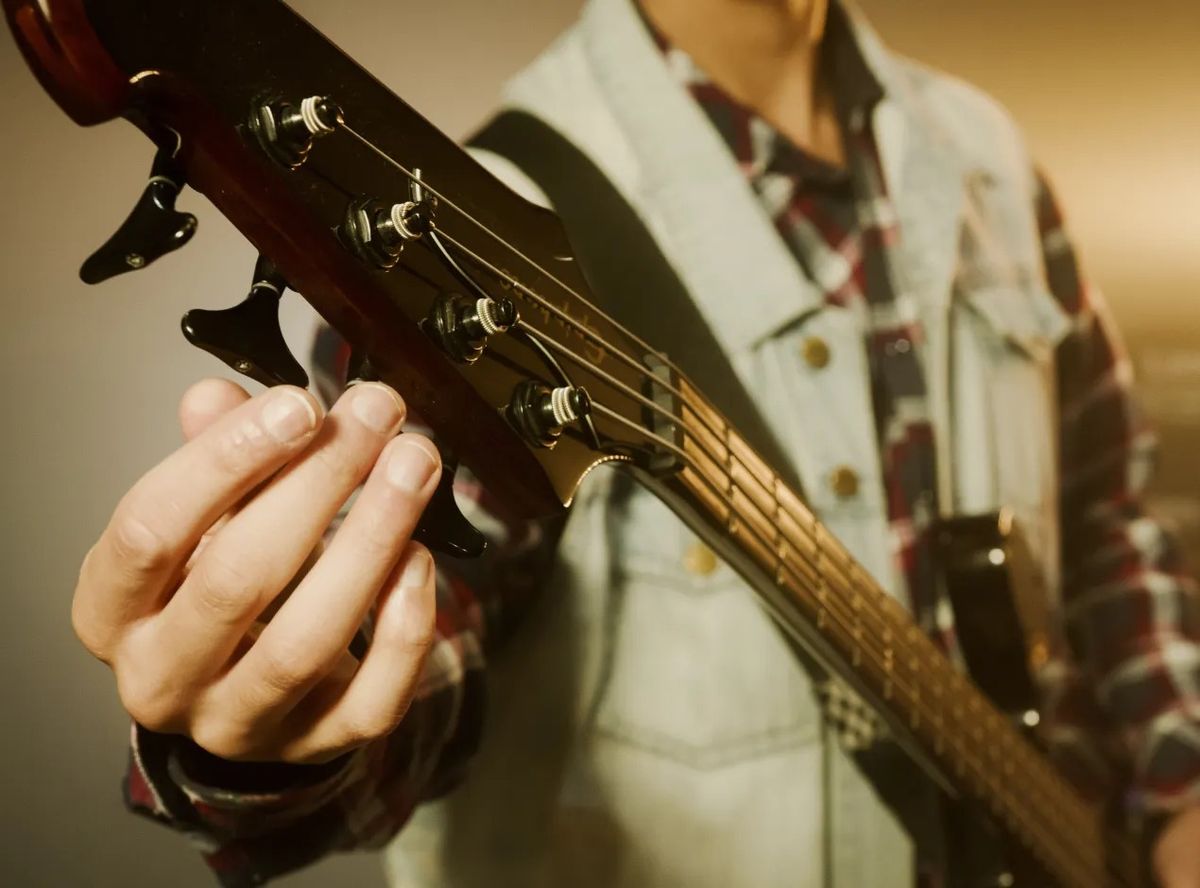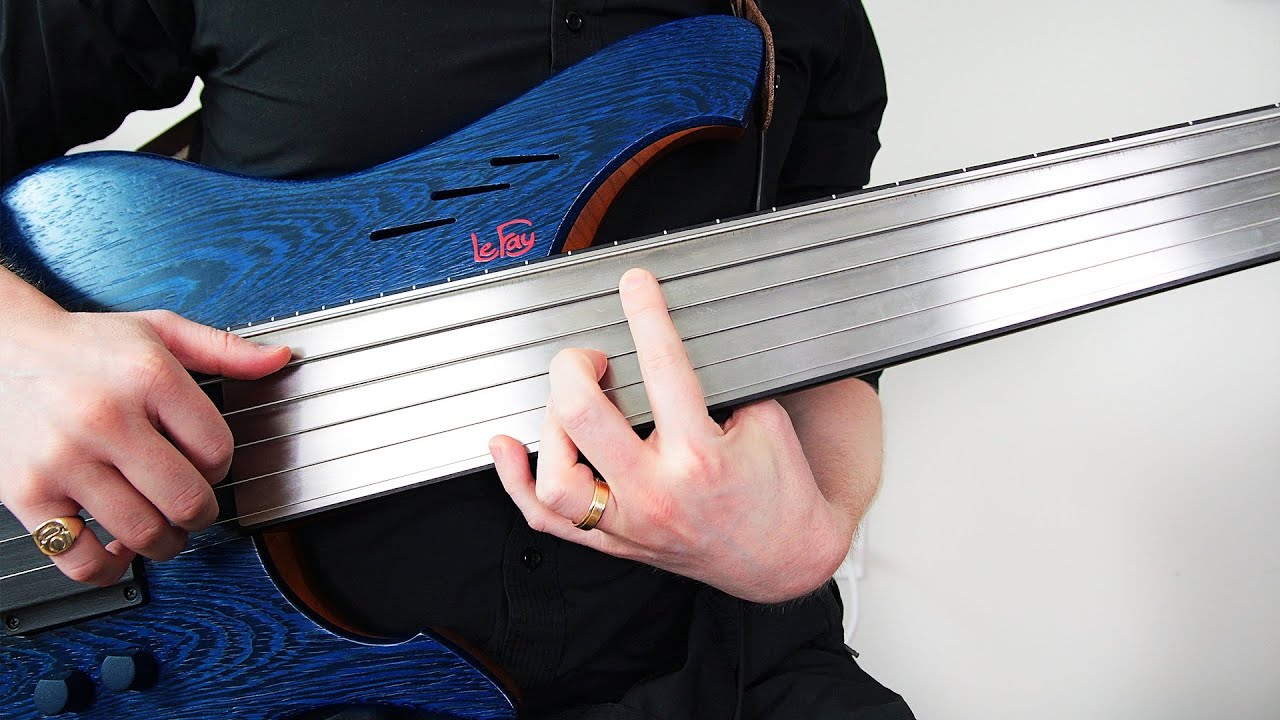Home>Instruments>Bass>How To Learn To Play Bass


Bass
How To Learn To Play Bass
Modified: January 22, 2024
Learn how to play bass with step-by-step tutorials, tips, and techniques to master the bass guitar. Discover the secrets to creating grooving basslines and becoming a skilled bassist.
(Many of the links in this article redirect to a specific reviewed product. Your purchase of these products through affiliate links helps to generate commission for AudioLover.com, at no extra cost. Learn more)
Table of Contents
- Introduction
- Getting Started with the Bass
- Basic Techniques and Terminology
- Learning Music Theory for Bass
- Practicing and Developing Your Skills
- Playing with Others: Joining a Band or Jamming with Friends
- Expanding Your Bass Repertoire
- Tips for Improving Your Bass Playing
- Troubleshooting Common Challenges
- Conclusion
Introduction
Welcome to the world of bass playing! Whether you’re a beginner or looking to hone your skills, learning to play bass can be a rewarding and exhilarating journey. The bass guitar plays a crucial role in any band or ensemble, providing the foundation and groove that ties the music together.
In this article, we will guide you through the process of learning to play bass and help you develop a strong foundation that will allow you to explore various genres and styles. From basic techniques and terminology to music theory and practical tips, we will cover everything you need to know to become a proficient bass player.
Before we dive into the nitty-gritty details, let’s start with some basics. The bass guitar is a four-stringed instrument that is played by plucking or strumming the strings with your fingers or a pick. It is similar in appearance to the electric guitar but has a longer neck and thicker strings.
One of the key roles of the bass guitar is to provide the rhythmic foundation for a song. The bass line typically complements the drumbeat and provides the harmonic structure of the song. It adds depth and richness to the music, creating a solid groove that drives the rhythm forward.
Learning to play bass can be a deeply satisfying experience. As you develop your skills and become more comfortable with the instrument, you’ll discover the joy of locking in with the drummer, experimenting with different bass lines, and improvising during jam sessions.
Whether you aspire to join a band, perform on stage, or simply enjoy playing bass for personal enjoyment, this guide will equip you with the knowledge and techniques to reach your goals. So, let’s jump right in and get started on your bass playing journey!
Getting Started with the Bass
When you first pick up a bass guitar, it’s important to familiarize yourself with its parts and make sure it’s properly tuned. The main components of a bass guitar include the body, neck, fretboard, pickups, and controls. Take some time to explore these elements and get comfortable holding and playing the instrument.
Next, let’s talk about the right posture and hand positioning. Proper posture will not only improve your technique but also prevent strain and injury. Sit or stand up straight, with the bass resting comfortably against your body. Keep your fretting hand relaxed and curved while placing your thumb behind the neck for stability. The picking hand should hover over the strings with a relaxed wrist and fingers.
Now that you’re ready to start playing, let’s focus on the three fundamental techniques: fingerstyle, pick, and slap. Fingerstyle involves using your fingers (usually index and middle) to pluck the strings individually. This technique offers more control and versatility, allowing you to create various tones and dynamics. Using a pick provides a brighter and more powerful sound, great for genres like rock and punk. Slap technique involves striking the strings with the thumb and popping them with the fingers, resulting in a percussive and funky sound.
As a beginner, it’s essential to start practicing with a metronome or a drum track to develop your sense of timing and rhythm. Start with simple exercises, such as playing scales, chromatic exercises, and basic patterns. Focus on accuracy and consistency, gradually increasing your speed as you feel more comfortable.
When it comes to bass playing, understanding music theory is crucial. Learn the names of the notes on the fretboard and how they relate to the musical alphabet. Familiarize yourself with scales, chords, and intervals, as they form the building blocks of music. This knowledge will enable you to improvise, compose, and communicate with other musicians effectively.
Lastly, don’t forget to have fun and experiment! Play along with your favorite songs, jam with friends, and explore different genres. The more you enjoy the process, the more motivated you’ll be to practice and improve.
Now that you have a solid foundation, it’s time to dive deeper into bass techniques and expand your musical horizons. Stay tuned for the next section as we discuss basic techniques and terminology for bass players.
Basic Techniques and Terminology
Understanding and mastering basic techniques is essential for any bass player. These techniques will not only improve your playing but also help you navigate through various musical styles and genres. Let’s explore some of the fundamental techniques and important terminology in the world of bass playing.
1. Plucking Techniques: The two primary plucking techniques used in bass playing are fingerstyle and picking. Fingerstyle involves using your fingers to pluck the strings individually, providing greater control over dynamics and accentuation. Picking, on the other hand, involves using a pick to strike the strings for a more defined and aggressive sound. Experiment with both techniques and find what works best for you.
2. Slapping and Popping: Slap bass is a popular technique that produces percussive and funky sounds. To slap, you strike the strings with the thumb of your plucking hand, creating a sharp, percussive attack. Popping involves using your fingers to pull or “pop” the strings, producing a snapping sound. Mastering slap and pop techniques adds flair and excitement to your bass playing.
3. Hammer-ons and Pull-offs: Hammer-ons and pull-offs are techniques used to create smooth and fluid transitions between notes. A hammer-on is when you play a note by “hammering” your finger down onto the string, without plucking it. A pull-off is the opposite, where you release a finger from a note to produce a lower tone. These techniques allow you to play legato passages and add expressiveness to your playing.
4. Slides and Bends: Slides involve moving your finger up or down the fretboard while continuously sounding the note. Slides can add a smooth and seamless quality to your bass lines. Bends, on the other hand, involve pushing or pulling the string to change the pitch while sustaining the note. Bends add emotion and character to your playing, mimicking the expressive capabilities of vocalists.
5. Terminology: As with any instrument, there are important terms specific to bass playing that you should familiarize yourself with. Some essential terms include: scales (patterns of notes used to create melodies and harmonies), arpeggios (playing the individual notes of a chord in succession), octaves (doubling a note at a higher or lower pitch), and groove (the rhythmic feel and coordination between bass and drums). Understanding these terms will enhance your communication with other musicians and deepen your understanding of bass playing.
By mastering these basic techniques and becoming familiar with important terminology, you’ll have a solid foundation to build upon. Remember to practice regularly, start slowly, and gradually increase your speed and complexity. The more you practice and experiment with different techniques, the more versatile and confident you’ll become as a bass player.
Next, we’ll dive into the world of music theory for bass players, where we’ll explore scales, chords, and harmonic concepts. Stay tuned!
Learning Music Theory for Bass
Understanding music theory is essential for any bass player looking to expand their musical vocabulary and communicate effectively with other musicians. While it may seem intimidating at first, learning music theory will greatly enhance your bass playing abilities and open up a world of possibilities. Let’s delve into the key aspects of music theory that every bass player should know.
1. Scales: Scales are the foundation of melody and harmony. Familiarize yourself with the major and minor scales, as they are the most commonly used in music. Learn the patterns and fingerings for these scales on the bass fretboard. Practicing scales will not only improve your technique but also help develop your ear for pitch and intervals.
2. Chords: Understanding chords is crucial for creating harmonies and playing with other musicians. Learn the basic triads (major, minor, diminished) and their inversions. Experiment with different chord progressions to understand the relationship between chords in a song. This knowledge will enable you to create interesting bass lines that complement the harmony.
3. Intervals: Intervals refer to the distance between two notes. Knowing and recognizing intervals is essential for playing melodies and constructing bass lines. Learn to identify intervals by ear and on the fretboard. This skill will enable you to play bass lines by ear, improvise, and transcribe music more accurately.
4. Rhythm and Timing: As a bass player, your primary responsibility is to maintain the rhythm and groove of a song. Develop a strong sense of timing by practicing with a metronome or drum machine. Understand various rhythmic patterns and subdivisions, such as quarter notes, eighth notes, and sixteenth notes. This knowledge will help you stay in sync with the drummer and other band members.
5. Ear Training: Training your ear is crucial for recognizing melodies, harmonies, and chord progressions. Practice recognizing different intervals, chords, and melodies by ear. Transcribe bass lines from songs you enjoy and try to play them by ear. Over time, your ear will become more attuned to the nuances of music, allowing you to improvise and create bass lines more intuitively.
6. Music Notation: Familiarize yourself with music notation, including reading sheet music and tablature. Knowing how to read standard notation will allow you to access a vast library of sheet music and expand your repertoire. Tablature is a more common form of notation specifically for the bass guitar. Learn how to read bass tablature to quickly learn and play songs.
Learning music theory may take time and patience, but the benefits are well worth the effort. As you become proficient in music theory concepts, you’ll find that your ability to create bass lines, improvise, and communicate with other musicians will greatly improve. So, grab your bass and start exploring the fascinating world of music theory!
Coming up next, we’ll discuss effective practice techniques and strategies to help you develop your bass playing skills. Stay tuned!
Practicing and Developing Your Skills
Practicing regularly and efficiently is key to improving your bass playing skills. Whether you’re a beginner or an experienced player, implementing effective practice techniques will help you develop your technique, expand your musical vocabulary, and increase your overall proficiency. Here are some tips to make the most out of your practice sessions:
1. Set Specific Goals: It’s important to have clear and specific goals for each practice session. Identify areas that you want to improve, such as scales, finger dexterity, or learning a new song. Break down your goals into manageable tasks, and focus on one skill at a time to avoid feeling overwhelmed.
2. Warm-Up Exercises: Start each practice session with warm-up exercises to gradually loosen up your fingers and prepare your muscles. This can include stretching, playing scales, or simple finger exercises. Warming up will not only prevent injuries but also improve your overall playing technique.
3. Technique Practice: Devote a portion of your practice time to working on specific techniques, such as fingerstyle, picking, or slapping. Use exercises that focus on these techniques, gradually increasing the difficulty as you become more proficient. Focus on precision, control, and smooth transitions between techniques.
4. Scale and Chord Practice: Dedicate time to practicing scales and chords. Work on different scales (major, minor, pentatonic, etc.) and their variations across the fretboard. Practice playing arpeggios and chord progressions to strengthen your understanding of harmonies. This will improve your improvisation skills and ability to create bass lines that complement the song.
5. Ear Training and Transcribing: Develop your ear by practicing ear training exercises and transcribing bass lines and melodies from songs you enjoy. This will enhance your ability to play by ear, recognize intervals, and replicate musical phrases. Start with simple songs and gradually move on to more complex pieces.
6. Playing with Backing Tracks or a Metronome: Use backing tracks or play along with a metronome to improve your sense of timing and rhythm. Start slowly and gradually increase the tempo as you become more comfortable. Playing with a consistent beat will help you internalize the groove and develop a tight sense of timing.
7. Experiment and Play with Others: Don’t be afraid to experiment and explore different styles and genres. Jamming with other musicians or playing in a band setting allows you to apply your skills in a real-time musical context. It also helps you develop your ability to listen and collaborate with other musicians.
8. Consistency is Key: The more regularly you practice, the faster you’ll progress. Aim for consistent daily practice, even if it’s for shorter durations. Consistency is more important than practicing for long hours sporadically. Set a practice schedule that works for you and stick to it.
Remember, the goal is to practice effectively and efficiently. Quality practice focused on specific goals will yield better results than mindlessly running through the same exercises. Each practice session is an opportunity to improve your technique, expand your musical knowledge, and become a better bass player.
Next, we’ll delve into the world of playing with others, whether it’s joining a band or jamming with friends. Stay tuned!
Playing with Others: Joining a Band or Jamming with Friends
Playing with others is an exciting and valuable experience for any bass player. It allows you to apply your skills in a collaborative setting, develop your musical intuition, and create dynamic and engaging music together. Whether you’re joining a band or jamming with friends, here are some tips to enhance your playing and make the most out of these musical opportunities:
1. Find Musicians with Similar Interests: Look for musicians who share your musical taste and goals. Join online communities, local music scenes, or attend open jam sessions. Connecting with musicians who have similar interests will create a more enjoyable and cohesive playing experience.
2. Listen and Communicate: When playing with others, it’s crucial to listen attentively to the music being created. Pay attention to the dynamics, rhythm, and melodies being played. Communicate with your bandmates and discuss ideas, arrangements, and musical directions. Effective communication ensures everyone is on the same page and improves the overall musical performance.
3. Lock-In with the Rhythm Section: As a bass player, your role is to lock in with the drummer and establish a solid rhythmic foundation. Pay close attention to the drummer’s kick drum and snare hits and synchronize your bass lines accordingly. The tight connection between the bass and drums creates a strong groove that forms the backbone of the music.
4. Experiment with Different Bass Lines: While it’s important to play in sync with the other musicians, don’t be afraid to experiment with various bass lines and rhythmic patterns. Explore different registers of the bass, use techniques like slides, bends, and harmonics, and try alternate chord voicings to add depth and variety to the music.
5. Support the Song and Spotlight the Music: Remember that your role as a bass player is to support the song rather than show off your skills. Focus on providing a solid foundation and filling in the spaces between the melodies and rhythms. At the same time, be open to taking solo breaks or highlighting certain musical sections when appropriate.
6. Be Flexible and Adaptable: Playing with others requires flexibility and adaptability. Be open to feedback and suggestions from your bandmates. Adjust your playing style and technique to fit the musical context. Embrace collaboration and be willing to compromise for the benefit of the music.
7. Rehearse Regularly: Regular rehearsals are essential for a cohesive band dynamic. Set a schedule and commit to it. Use rehearsal time to work on arrangements, transitions, dynamics, and refining your parts. Regular rehearsals will help you establish a tight musical bond with your bandmates.
8. Enjoy the Creative Process: Playing with others is a chance to tap into your creativity and express yourself through music. Enjoy the creative process of collaborating, experimenting, and discovering new musical possibilities. Embrace the joy of making music with others and cherish the camaraderie that comes with being part of a musical community.
Playing with others is a valuable and rewarding experience that will enhance your musicianship and deepen your understanding of music. Whether you’re performing on stage or jamming in a basement, cherish the musical connections you make and embrace the opportunities for growth and exploration.
Next, let’s discuss expanding your bass repertoire and exploring different musical genres. Stay tuned!
Expanding Your Bass Repertoire
Expanding your bass repertoire is crucial for musical growth and versatility as a bass player. By exploring different genres, styles, and techniques, you can develop a broader musical vocabulary and adapt to various musical contexts. Here are some tips to help you expand your bass repertoire:
1. Explore Different Genres: Venture beyond your comfort zone and explore genres outside of your usual preferences. Try playing funk, jazz, reggae, blues, rock, or even genres like Latin or fusion. Each genre will offer unique rhythmic patterns, chord progressions, and playing styles, allowing you to broaden your musical horizons.
2. Transcribe Songs: Choose songs from different genres and artists that inspire you and transcribe their bass lines. Transcribing involves listening closely to the bass part, figuring out the notes and rhythms, and recreating them on your instrument. Transcription helps you understand the melodic and harmonic choices made by experienced bass players, helping you incorporate their techniques and ideas into your playing.
3. Study Iconic Bassists: Study the work of iconic bassists across various genres. Listen to their recordings, watch live performances, and analyze their techniques and musical approaches. Each bassist brings their unique style and perspective, offering valuable insights for your own playing. Some influential bassists to explore include Jaco Pastorius, James Jamerson, Flea, Victor Wooten, and Marcus Miller, among many others.
4. Learn Basslines from Different Eras: Take a journey through different eras of music and learn basslines from different time periods. Explore the iconic basslines of Motown, disco, classic rock, and modern pop. Studying basslines from different eras will expose you to various playing techniques, rhythmic styles, and production approaches, enriching your musical repertoire.
5. Experiment with Different Techniques: Don’t limit yourself to a single technique or playing style. Experiment with fingerstyle, picking, slapping, tapping, and any other techniques you come across. Each technique offers unique tonal possibilities and can inspire new musical ideas. Incorporating different techniques into your playing will make you a more versatile bassist.
6. Learn from Music Theory: Deepen your understanding of music theory and how it applies to the bass. Learn about different chord progressions, scales, modes, and harmonic concepts. This knowledge will enable you to create basslines that fit different musical contexts and contribute effectively to the overall harmony and groove of a song.
7. Play with Other Musicians: Collaborate with other musicians, whether it’s joining a band, participating in jam sessions, or attending workshops. Playing with others exposes you to different musical perspectives and challenges you to adapt and respond in real-time. It’s an excellent opportunity to incorporate new ideas and techniques into your playing.
8. Keep Pushing your Boundaries: As you expand your bass repertoire, don’t be afraid to push your boundaries and try new things. Continuously challenge yourself by tackling more complex songs, experimenting with improvisation, and seeking out new musical experiences. Embrace the process of growth and embrace the joy of exploring new musical territories.
By expanding your bass repertoire, you’ll become a more versatile and well-rounded bass player. So, go ahead and explore different genres, techniques, and musical styles. Embrace the diversity of the bass world and enjoy the journey of expanding your musical horizons!
Next, we’ll share some valuable tips for improving your overall bass playing skills. Stay tuned!
Tips for Improving Your Bass Playing
Improving your bass playing skills requires dedication, practice, and a focus on continuous improvement. Whether you’re a beginner or an experienced player, here are some valuable tips to help you enhance your bass playing:
1. Practice Consistently: Consistent practice is key to improving your bass playing. Set aside regular practice sessions and stick to a routine. Even just 15-30 minutes of focused practice per day can yield significant results over time. Consistency is more important than long practice sessions done sporadically.
2. Develop Finger Strength and Dexterity: Build strength and dexterity in your fingers by practicing exercises that target finger independence and control. This will enable you to play more complex basslines with ease. Scales, arpeggios, and fingerstyle exercises are great for developing finger strength and control.
3. Emphasize Accuracy and Timing: Focus on playing with precision and accuracy. Pay close attention to your timing and aim to play with a solid sense of rhythm. Use a metronome or play along with backing tracks to improve your timing and feel for the groove.
4. Improve Ear Training: Developing your ear is essential for playing bass. Practice identifying intervals, scales, and chord progressions by ear. Transcribe basslines and melodies from songs you enjoy to further enhance your ear training skills. Ear training will improve your ability to play by ear and contribute to the overall musicality of your playing.
5. Expand Your Musical Knowledge: Study music theory to enhance your understanding of harmony, scales, and chord progressions. Familiarize yourself with different styles and genres to broaden your musical vocabulary. The more you expand your musical knowledge, the more you can bring to your bass playing.
6. Play with a Metronome or Drum Tracks: Develop a strong sense of timing and rhythm by practicing with a metronome or drum tracks. Start with slower tempos and gradually increase the speed as you become more comfortable. Playing in time with a metronome will help you develop a solid sense of groove and improve your ability to lock in with other musicians.
7. Learn Songs by Ear: Train your ability to play by ear by learning songs without relying on sheet music or tabs. Listen closely to the basslines in songs and figure them out on your own. This will improve your note recognition, finger placement, and overall understanding of how basslines are constructed.
8. Experiment with Tone and Effects: Explore different bass tones and experiment with effects pedals to find your unique sound. Don’t be afraid to explore different EQ settings, pickup configurations, and effects to shape your tone and add color to your playing.
9. Record and Analyze Your Playing: Take advantage of technology and record yourself playing. Listen back to your recordings with a critical ear and analyze your performance. Identify areas for improvement, such as timing, phrasing, and technique. Regularly recording and analyzing your playing will help you identify strengths and weaknesses and track your progress over time.
10. Seek Inspiration and Learn from Others: Listen to a wide range of bass players and musicians. Study the techniques, styles, and musicality of both famous and lesser-known bassists. Attend live performances, watch instructional videos, and take part in workshops to gain inspiration and learn new ideas and techniques.
Remember, the journey to becoming a better bass player is ongoing. Embrace every opportunity to learn, practice, and evolve. With dedication and perseverance, you’ll continuously improve your skills and reach new heights in your bass playing.
Finally, let’s address some common challenges that bass players face and how to overcome them. Stay tuned!
Troubleshooting Common Challenges
As a bass player, you may encounter certain challenges along your musical journey. While these challenges can be frustrating, they are also valuable opportunities for growth and improvement. Here are some common challenges that bass players face and tips on how to overcome them:
1. Fretting Hand Fatigue: Playing bass requires strength and endurance in the fretting hand. If you find yourself experiencing hand fatigue, take breaks during practice sessions and gradually build up your stamina. Incorporate finger stretching exercises and hand conditioning routines into your warm-up routine to improve finger strength and dexterity.
2. Timing and Rhythm Issues: Timing and rhythm are crucial for bass players. If you struggle with these aspects, practice with a metronome or drum tracks to develop a solid sense of timing. Focus on locking in with the drummer and pay attention to the relationship between the bassline and the drum groove. Additionally, studying different rhythmic patterns and subdivisions will improve your overall rhythm skills.
3. Lack of Music Theory Knowledge: Understanding music theory is essential for bass players, as it helps you communicate with other musicians and navigate the harmonic and melodic aspects of a song. If you feel limited in your music theory knowledge, dedicate time each day to study and practice theory concepts. Start with the basics, such as scales, intervals, and chord progressions, and gradually build your knowledge from there.
4. Inconsistent Tone: Achieving a consistent and desirable tone is a challenge for many bass players. Experiment with your instrument’s settings, such as pickup selection, tone knobs, and string gauge. Additionally, consider your playing technique and attack. Adjusting your finger placement and using different plucking techniques can significantly impact your tone. Take the time to listen critically to your tone and make adjustments as necessary.
5. Playing with a Band: Playing in a band requires strong communication and adaptability. If you find it challenging to play with a band, focus on active listening and paying attention to the other musicians. Practice locking in with the drummer’s kick drum and developing a solid groove. Communicate openly with your bandmates and be receptive to their feedback and suggestions. With time and experience, playing with a band will become more natural and enjoyable.
6. Lack of Creativity: If you’re struggling to come up with unique and creative basslines, experiment with different techniques, styles, and musical influences. Practice improvisation by jamming along with backing tracks or through freeform jam sessions. Listen to a variety of bass players across different genres, and be open to incorporating their ideas and techniques into your playing. Remember, creativity is a journey, so keep exploring and pushing your boundaries.
7. Getting Stuck in a Rut: It’s not uncommon for bass players to feel stuck in a rut or plateau. To overcome this, challenge yourself by learning new songs, techniques, or styles that are outside of your comfort zone. Set new goals for yourself, such as mastering a challenging bassline or improvising over complex chord progressions. Seek inspiration from other musicians and attend live performances to reignite your passion and motivation.
8. Perfectionism and Self-Criticism: It’s important to strive for excellence, but don’t let perfectionism hinder your progress. Celebrate your achievements, no matter how small, and recognize that progress comes with time and dedication. Instead of being overly critical of yourself, focus on continuous improvement and enjoy the journey of becoming a better bass player.
Remember, perseverance and a positive mindset are essential when facing challenges. Embrace them as opportunities for growth and improvement. With time, patience, and consistent effort, you’ll overcome these challenges and continue to grow as a skilled and confident bass player.
Finally, let’s summarize the key takeaways from this guide to learning and mastering the bass. Stay tuned!
Conclusion
Congratulations on completing this comprehensive guide to learning and mastering the bass! We’ve covered a wide range of topics, from getting started with the bass to expanding your repertoire and troubleshooting common challenges. By implementing the tips and techniques outlined in this guide, you’re well on your way to becoming a skilled and versatile bass player.
Remember, learning the bass is a journey that requires dedication, practice, and an open mind. As you progress, continue to challenge yourself, explore new genres and techniques, and seek inspiration from other musicians. Embrace the joy of playing with others and the creative possibilities that the bass guitar offers.
Set specific goals for yourself, whether it’s mastering a particular technique, learning a challenging bassline, or joining a band. Break down these goals into manageable steps and focus on consistent and deliberate practice. Celebrate your accomplishments along the way and maintain a positive mindset, knowing that growth takes time.
Never stop learning and seeking new opportunities to expand your musical horizons. Attend concerts, workshops, and jam sessions to connect with other musicians and gain valuable insights. Keep listening to diverse bass players and studying the works of iconic musicians across different genres.
Remember, the bass guitar is not just an instrument, but a powerful tool to express your musicality and contribute to the rhythm and harmony of a song. Enjoy the process, be patient with yourself, and continue to nurture your passion for the bass.
So, keep practicing, keep exploring, and keep pushing the boundaries of your bass playing abilities. With dedication, perseverance, and a love for music, you will continue to grow as a bass player and find fulfillment in creating music. Happy playing!











